Acapella NEXT
SEAS W22NY001 + W18NX001 + T29CF001
3-way, semi-dipole construction
December 2007-January 2008


During crossover fine-tuning (picture above to the left) I connected the 2 x 6 watts single ended MAE amp. The impedance of this speaker construction is fairly flat from upper bass to the top octave. However, at 150 Hz we have a negative phase shift due to the vented cabinet and impedance reaches it lowest level at 3.8 ohms. Despite ~90 dB/2.8V system sensitivity, I hadn't any expectation of this speaker being run from 6 watt single ended. Let me immediately say the MAE is not the ideal amp for this speaker, but I was surprised how loud it could play the Acapella NEXT. Louder than my wife would do when she plays her CDs. Hmm... as discussed before, you have to try any combination of speakers and amps before deciding what goes and what doesn't. My Autumn sale was a goodbye to my Acapella SEas speakers. Drivers, crossovers, vents, terminals, damping material, wires, everything but the cabs. You don't ship these caps to Portugal unless you make huge crates with loads of absorbent material. So, the cabs stayed and having the W18 and T29 drivers the only thing left to do was ordering the W22 bass units - and see if a fairly high efficient Acapella could be made. The W22 comes with a huge 134 mm magnet and promises 90 dB sensitivity. Not bad at all. Maybe the W18 could even be run without any attenuation.... So, the Acapella NEXT was born. My visitors have been quite taken by the initial Acapella NEXT set-up. The airiness of the midrange (lack of box colouration), the excellent mid-tweeter integration, the dynamic properties due to relatively high sensitivity. And they were surprised when I connected the 6 wpc SET MAE amp. The treble is a little laid-back when driven from the MAE (4R7 to tweeter), where my 20 wpc SET Audio Mirror mono-blocks have no trouble driving this speaker to considerable levels. The best Acapella yet? Yes and no. If you can live with the slightly reduced low end extension compared to the Acapella SEas, then yes. I like these nextel coated drivers. They can be driven hard without noticeable distortion. They appear surprisingly un-coloured although not as "clean" as the magnesium drivers. But what we're in for here is some 5 dB rise in sensitivity compared to the magnesium version of this construction. The Acapella SEas is tuned to some 84-85 dB sensitivity, so we should have an almost 4 times more sensitive speaker. The T29CF001 is a magnificent tweeter. The Sonomex cone material appears to be a good compromise between hard domes and soft domes. The Sonomex is significantly more rigid compared to classic silk domes and the frequency response should reach up to 30 kHz according to SEAS measurements. My CLIO system only goes to 22 kHz. Initial LspCAD modelling suggested a very easy crossover compared to the difficult magnesium drivers. 2nd order to bass and mid and a 3rd order to the tweeter should be all needed and so it stayed after crossover fine-tuning. The roll-off of the W22 driver is an example to follow. My measurement of the raw W22 driver was spot on compared to the SEAS specs. Always nice to be able to reproduce measurements. View graphics at end of measurement section. |


The Cabs
download Acapella drawings, zip file


TS data and box simulation

SEAS data for W22NY001
Comparing bas extension from W22EX001 and W22NY001 from same cabinet volume.
Ports for 36-38 Hz tuning:
60 x 90 mm, or 65 x 110 mm, or 68 x 120 mm, or 72 x 140 mm
The Crossover
The rationale behind the three 10W 6.8 ohm resistors in parallel is to
keep the resistors providing mid attenuation absolutely cool. Maybe overkill, but it's cheap.
Acapella NEXT kit with all drivers and v1 crossover components from: http://jantzen-audio.com/ |
Measurements
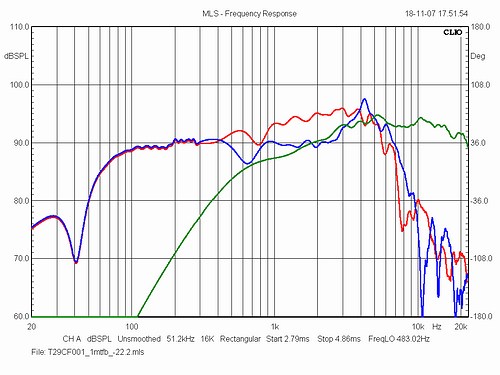

Left: SPL @ 2.8V from all drivers mounted in cabinet. Bass driver response merged with nearfield measurement at 300 Hz. Red = bass driver. Please notice an example to follow for the bass driver. Extended response up to 5 kHz followed by a smooth roll-off. (- sorry for merging the mid response too! Disregard blue below 300 Hz) |
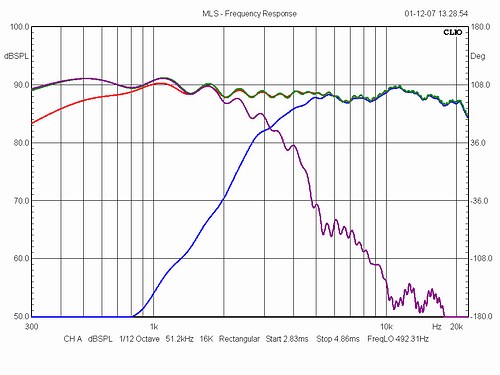
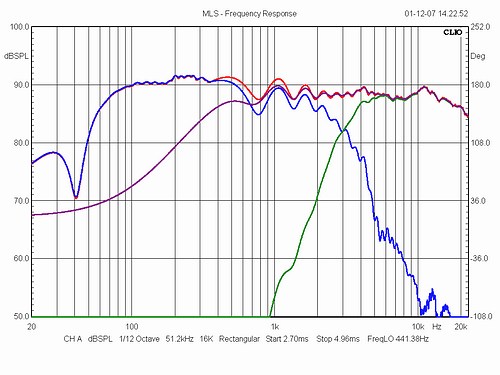
Left: Green = combined response from all drivers driven from crossover. Purple = bass + midrange. Blue = tweeter. Red = mid + tweeter. |
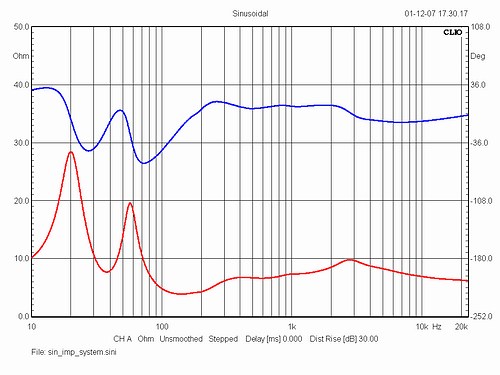

Left: System impedance. Minimum is 3.8 ohm at 150 Hz. To make a long story short: This is an easy speaker to drive and my 20 wpc single ended triodes have no trouble driving this speaker to considerable levels. |
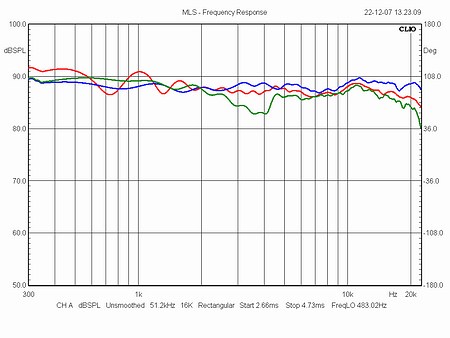
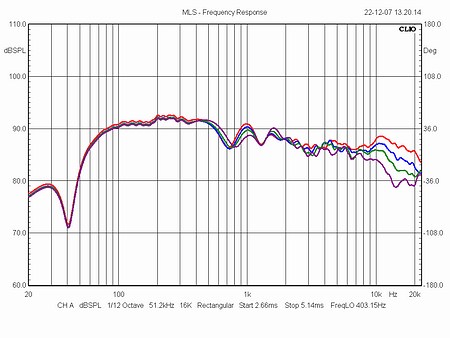
The above two measurements are not normalised for 1 m/2.8V. |
Out of curiosity I tried to overlay my W22NY001 measurement with the SEAS graph from the data sheet and I was pleased to see a good correlation between measurements. Blue = SEAS measurement. Red = my measurement where the response merged with nearfield response at 300 Hz is close to actual and predicted SEAS claims. |
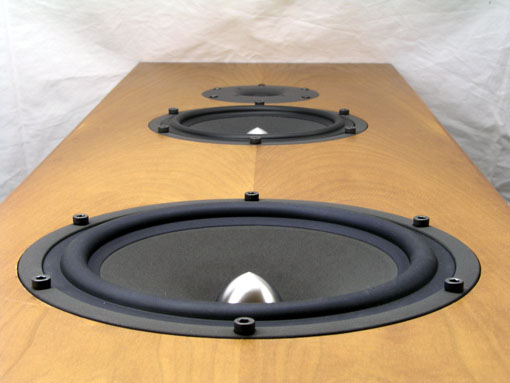
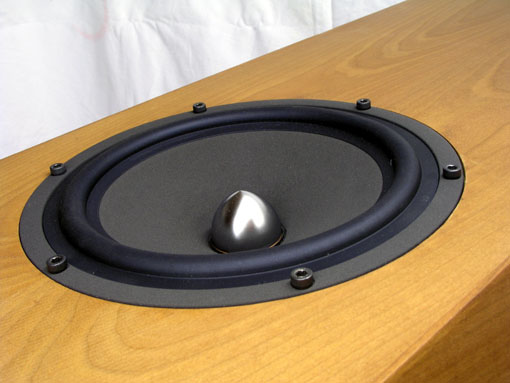
SEAS W22NY001 8" bass driver close-up.
I like this speaker so much I'm going to give the whole system an overhaul: Cabs need sanding and a fresh oil rub and I'm going to finish the rear grille, which has been on the shelf ever since I built the cabs. A new port must be installed and new binding posts as well. I'm going to use Jantzen Audio Superior Z-cabs for the tweeter and possibly for the mid as well. I mean: The drivers alone are some 1,000 EUR, so they deserve the best in terms of crossover components. First I'll try Cross Caps for the mid on one speaker and Superior Z-caps for the mid on the other and try an AB test. The crossover layout has to be prepared to 3 x 22 uF Superior Z-caps; takes quite some space, 123 x 106 mm. The bottom panel should leave plenty of room for the mid crossover. The bass crossover will be on the rear panel with the coil upwards to keep distance to mid crossover below. The tweeter crossover will be placed right above the tweeter like the Acapella SEas. |
Here are some pics from the work:
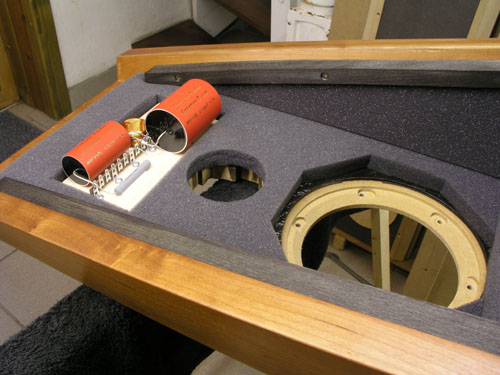
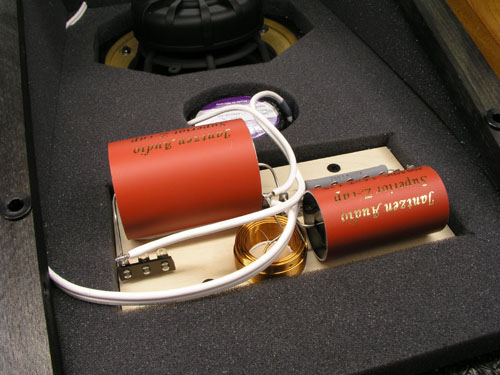
New foam has been added to the rear panel and the fillets holding the grille has been painted black.
Tweeter X-over is placed like before, right above tweeter.
2.5 mm^2 Supra mounting cable custom made for Jantzen Audio is used throughout.
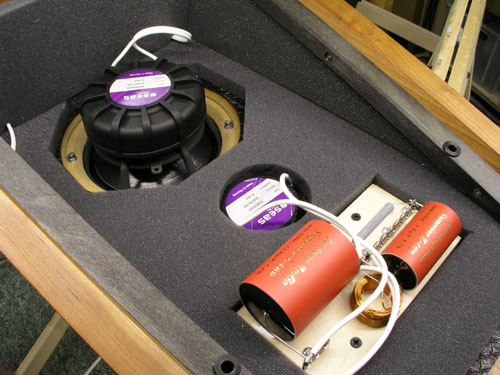
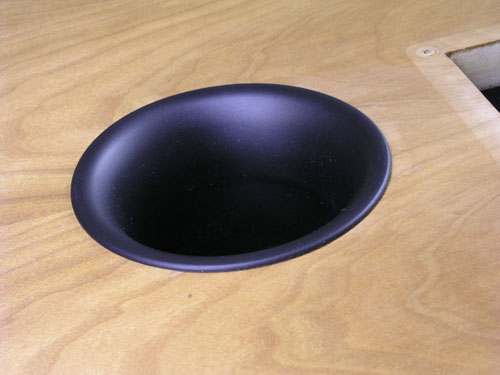
New port is installed. 68 x 120 mm.
Crossover layout-
tweeter and bass
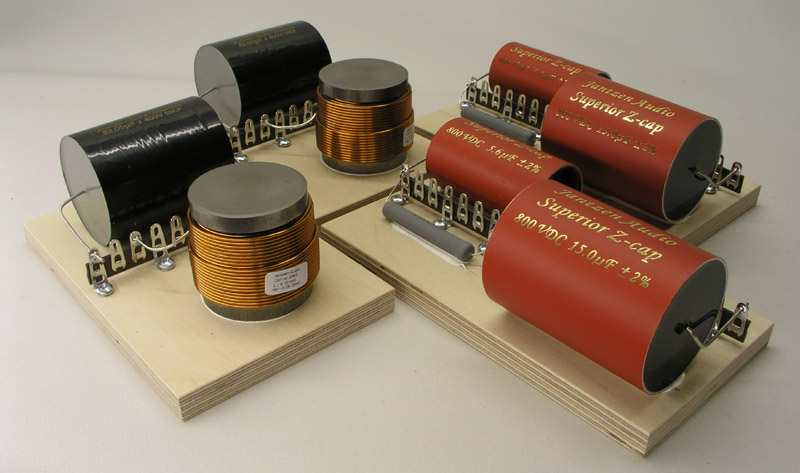
Crossover sections for bass and tweeter shaping up.
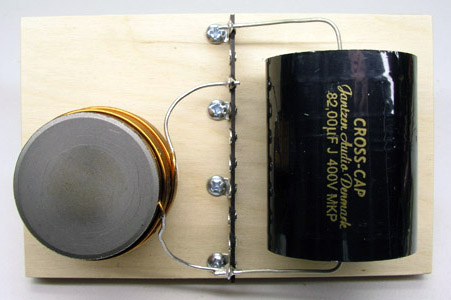
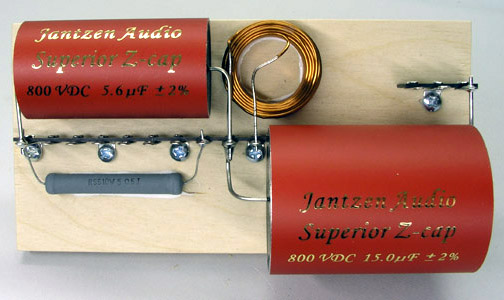
Left: Bass crossover section. Simple 2nd order.
Right: Tweeter crossover section, 3rd order.
Connection from bass and tweeter crossovers to drivers.
Mid x-over:
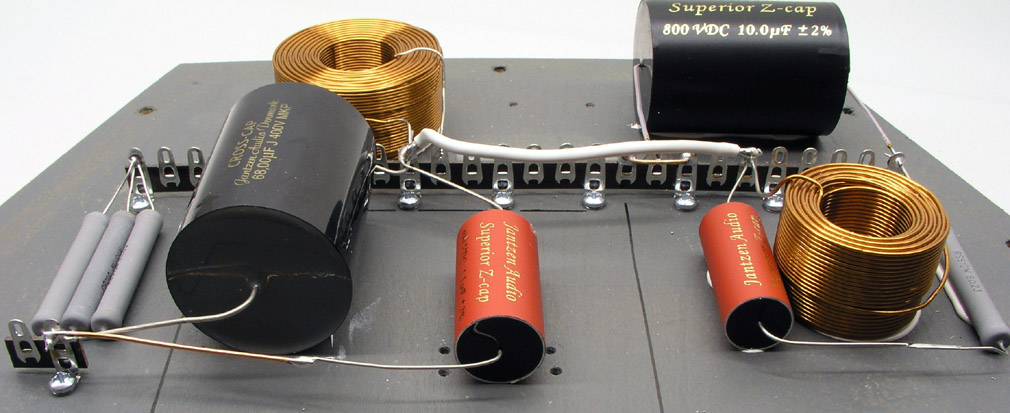
Now, this is a temporary set-up. The Superior Z-caps to the right is going to stay in place (1 uF + 8R2 bypassing the series 0.82 mH coil. The 10 uF Superior Z-cap goes to ground. The series 68 uF to the left is the series input capacitor making the high-pass filter together with the 4.5 mH + 4R7 going to ground. For my initial set-up I by-passed the 68 uF Cross-Cap with a 1.5 uF Superior to possibly optimise the performance of the Cross-Cap. So far, so good. Below to the right you can see a chunky load of paralleled Superior Z-caps making almost 68 uF capacitance. This is going into the other speaker and I'm going to AB-test these two speakers. Quite a challenge I think. Everything is the same except for the chunk of Superior Z-caps for the midrange in one speaker. Disregard the black colour of the 10 uF Superior Z-cap. This is a test samples I had before the bordeaux red colour was decided. |


Left: Mid X-over section seen from above. As can be seen, a lot of space is left open for 3 x 22 uF Superior Z-caps in parallel; black marking on bottom panel. |
Mid crossover layout for Superior Z-caps.
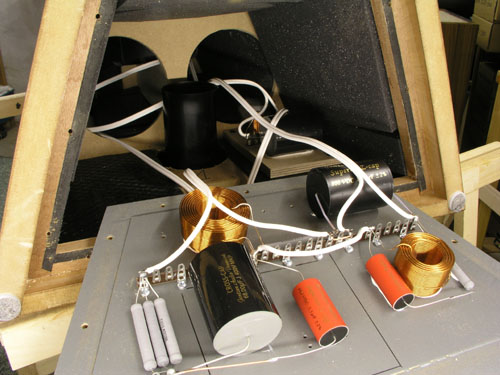
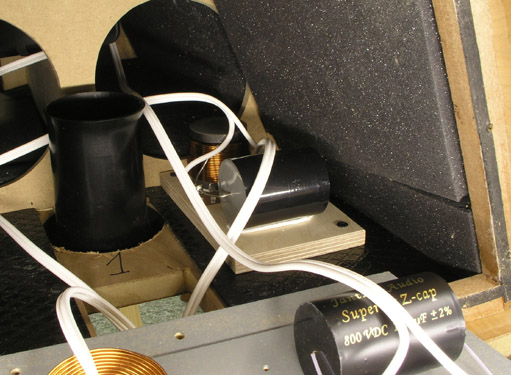
| Left: Mid X-over section ready for installation. Right: Bass X-over section on rear panel with coil as far away as possible from mid section coils. Before fastening the bottom panel, two sheets of MDM3 damping material were folded and placed above mid X-over. Take care not to block vent. |
Sonic evaluation of mid series capacitor contest Well, this is difficult! Having set up the two speakers as described above, the fun started. One speaker with Superior Z-caps (SZC) to the mid, the other with Cross-caps (CC). All other things the same. Frequency response was checked and was the same for the two speakers within 0.5 dB. It's hard to get any closer than that. In my workshop I have a connection panel attached to the power amp so that I can switch between two pairs of speakers. The two speakers certainly didn't sound the same. One brighter than the other. The CC version sounded brighter compared to the SZC, but at the same time, while listening to the SZC version my perception of the sound could swap - and all of a sudden I could hear the Superior Z-cap version being the brightest. Weird!! During this exercise I changed the position of the speakers from time to time - left and right. These are dipoles or rather semi-dipole speakers and highly dependent on room position. However, still what is described here followed the speakers no matter what position they had. The SZCs simply reveals details and a depth in the acoustic scenario the CCs are not capable of. The CCs certainly aren't bad, not at all. They very much sound like what we're used to hear from the majority of hifi-speakers. And if you don't have high-quality front end gear, forget about the SZC. It may not pay off and you should start looking elsewhere in the overall chain of components in your system. I once borrowed an expensive Parasound pre-poweramp set-up. Mega watts and I've never seen so many transistors and integrated circuits in a preamp. Sound? Nice, smooth - and utterly dull and un-inspiring. I better order 6 x 22 uF SZC. Having bundled my residual stock of Superior Z-caps I now have both running with SZCs and they are in my livingroom right now, driven from my 20 wpc SET amps. Thank Heaven I didn't get rid of the Acapella cabs during my Autumns sale. 20 wpc do well, even up to considerable levels, but ultimately I recommend 40 wpc really high-quality watts for these 90 dB/2.8V speakers. It will provide a more firm bass and the ability to play really loud too. What more can I say? Enjoy! |
- and here's the final mid Superior Z-caps
- some chunky beasts!
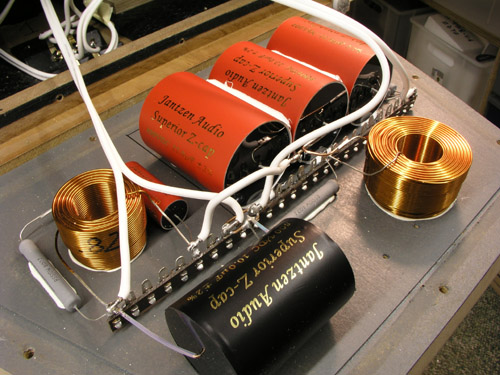
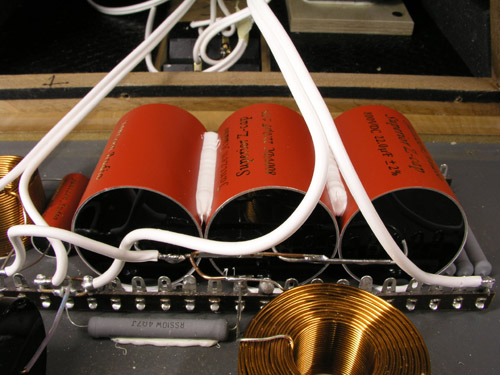





0 comentarii:
Trimiteți un comentariu